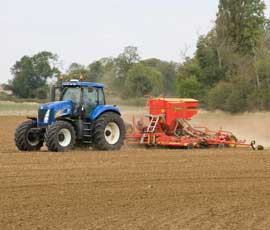OSR herbicide warning for coming autumn

Many rotations have been disrupted by the poor winter weather forcing changes to cropping plans this autumn, but one agronomist warns that growers need to take into account the possible effect of the previous season’s herbicides on the following crop.
“The crop that is most likely to be affected is oilseed rape, particularly as the preferred method of establishment is using non-inversion techniques, explains Frontier agronomist Brian Ross.
“Where tank-mixing or sequencing issues arise, the label will dictate how a following crop should be established and often that brings a requirement to cultivate to a depth of at least 15cm. Many herbicide products will have been applied much later than is usual in spring 2013, making following label instructions vital this year.”
Which products and crops are affected?
Late applications of iodosulfuron + mesosulfuron products (Atlantis or Pacifica) in a dry summer can adversely affect the following rape crop if the soil is not disturbed to a depth of at least 15cm, as advised on the label instructions.
Any use of products containing diflufenican brings a requirement to plough down to a depth of 15cm. Diflufenican, contained in Othello (iodosulfuron + mesosulfuron + diflufenican), has potential to cause bleaching of the cotyledon if soil is not sufficiently distributed.
Although this bleaching will normally be outgrown in an “average” year, late crops this season may mean this is not the case, highlighting the importance of following label advice carefully.
“Some growers may have managed to avoid any crop damage where diflufenican has been applied in the past, but this will usually have been where application took place earlier than this year,” says Mr Ross.
Where other sulfonylurea weed killers have been tank-mixed or sequenced there is no evidence to show problems will arise.
Where straight sulfonylurea only have been used, there are no establishment issue for following rape or beans. A dry, late spring/summer could cause issues to arise with following crops where growers have applied Lexus (flupyrsulfuron) in autumn 2012 and sequenced with another sulfonylurea. Again, this will all be ameliorated by soil disturbance.
Unite (flupyrsulfuron + pyroxsulam), Broadway Star (florasulam + pyroxsulam) and Sunrise (pendimethalin + pyroxsulam) do not have any special cultivation requirements if used alone. However, when applied in sequence with a straight metsulfuron-based product, the label states a requirement to plough to 15cm, whereas non-sulfonylurea sequences have no following crop restrictions.
Where Galaxy (clopyralid + florasulam + fluroxypyr) has been applied in spring 2013, pulses should not be drilled in the autumn. However, there are no cultivation restrictions for cereals or rape following Galaxy.
In cases of pea and bean crops that have been treated with Nirvana (imazamox + pendimethalin), rape must not be drilled as a following crop. Again, only cereals should be drilled with soil disturbance to 15cm.
Crops treated with Linzone (clomazone + linuron) and Cirrus (clomazone) carry a requirement to cultivate to 15cm before the following crop, especially in the event of a dry, late spring/summer.
“In essence, check with your agronomist and read the labels carefully before drilling crops such as rape or beans. In my opinion, the more cultivations, the safer the outcome – especially this season,” cautions Mr Ross.

